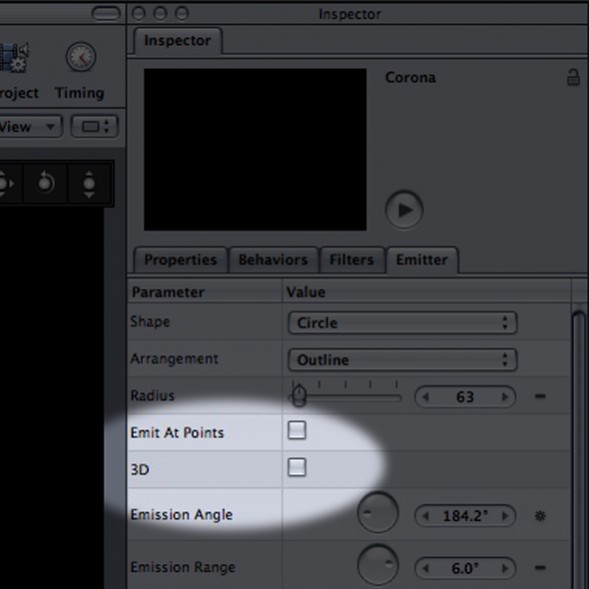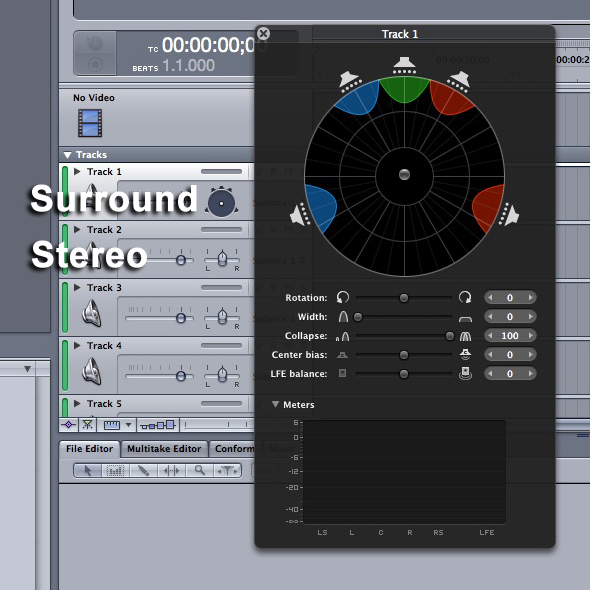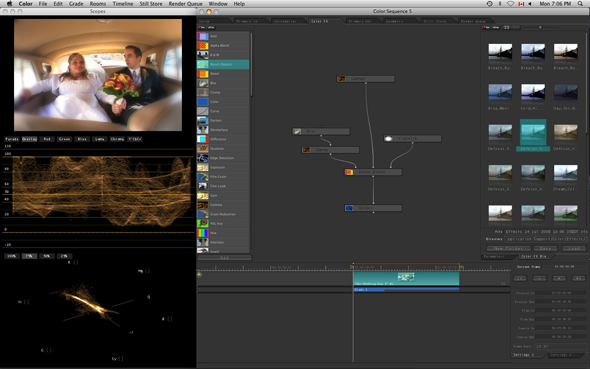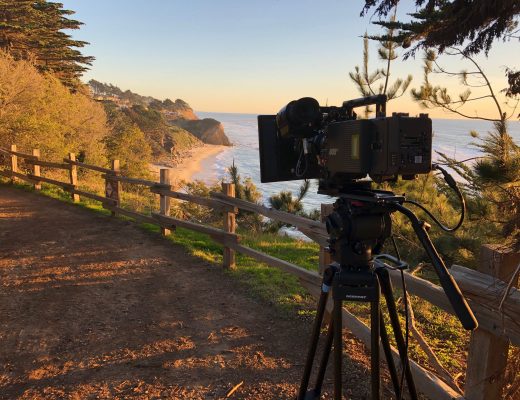With all the editing programs and packages on the market today, deciding on which one is right for you can be difficult and confusing. I thought I would take a look and list my top ten reasons why you should either switch to Final Cut Studio 2 or make it your first choice when buying for the first time!
10. SMOOTHCAM AND THE INTRODUCTION OF BACKGROUND PROCESSING
Anyone who has used Shake will be familiar with SmoothCam. It was designed to, as the name says, smooth out camera bumps and shakes in your footage. Most people might look at this and think that it is not really that big a deal, but believe me, it is. Why you ask? SmoothCam not only lets you smooth your footage out, but it introduces a new feature to Final Cut Pro that let’s you process the effect “live” in the background. The way the effect works is that once you add it to your timeline, FCP immediately starts analyzing the original clip to see what is happening inside the frame. Keep in mind, if the shot you captured was an hour long, it will process the whole hour long clip. In most cases, with anything that needs processing or analyzing, you would need to stop and wait for it to finish. Not anymore! Now, Final Cut Pro will analyze while you are working. Once you hit play on your timeline to see what you are working on, the analyzing will pause, and once you stop playing to do effects work, titles, etc, it will keep processing until it is done.
{C}

To be perfectly honest, once you apply the effect, you almost don’t even notice that it’s processing while you are working. This is exciting because not only does it let you keep working while your SmoothCam effect is being processed, but it opens the door to immense possibilities with other effects being able to do this same method of processing in future versions of Final Cut Pro.
9. A REAL THIRD DIMENSION IN MOTION 3
Other than with very specific plug-ins, you cannot do “true” 3D work in a motion graphics program, not even in After Effects. You can do a “fake” 3D where you can put flat 2D elements into 3D space, but that’s not real 3D. With Motion 3, that has all changed. Don’t get me wrong, you still can’t extrude text to make it true 3D, but what you can now do is make particles generate in three dimensions to get a truly realistic look to them. How does it work? Simple. Take a Particle Emitter (we’ll use Corona as our example), and apply it to your timeline. Add a new camera, and then add a simple “Camera Sweep” behavior so the camera arc’s around our burning ring of fire. Here’s what our end result would look like.
Wow, that’s boring! We’re stuck with the same flat 3D image….or are we? Navigate to your emitters properties, and you will notice that there is a little, tiny checkbox called “3D”.

Click on it to activate it, and now look at your particles. They move in not only the X and Y direction, but the Z direction as well. Look at what our burning ring of fire looks like now!
By the way, did I mention that I could preview this in real time as well? Totally awesome!
8. SURROUND SOUND MIXING IN SOUNDTRACK PRO 2
Now not only can we work with beautiful high definition images in Final Cut Pro, but we can compliment them by mixing our audio in surround sound in Soundtrack Pro 2. Take your FCP mix and “Send To” Soundtrack Pro, and surround sound is as simple as a click on your audio panner.

Depending on the capture card you are using (Kona, Blackmagic, etc), you can monitor your mix in true surround sound. Even Macbook Pro editors can buy a third party device to monitor their mixes in 5.1. Once you are done, you can either send it back to Final Cut as six discreet channels to be output to a deck like an SRW-5500 that supports up to 12 channels of audio, or you can export directly from Soundtrack Pro as a 5.1 AC-3 file to import into DVD Studio Pro, so your DVD can give viewers a true surround experience.
7. BUILD YOUR SYSTEM THE WAY YOU WANT IT
With other companies that make editing software, they have very stringent system requirements for you to run their programs “properly”. You need to use this CPU with this storage array with this capture card to do HD. Well, that’s not the way it is with Final Cut Studio 2. Want to do HD, but you only have a Macbook Pro? No problem, pick up AJA’s IoHD and you can use Apple’s newest HD codec ProRes and work off your internal HD or even an external FW800 drive, and cut in HD on your laptop.

Looking for a 4GB fibre storage device? No problem, why not look at Huge Systems Media Vault? Whatever your project needs, you can build the type of system you want to work with. Start with the tower (or laptop), and work your way to the type of capture card, storage and even the monitors that YOU want.
6. FXPlug
With the release of Final Cut Studio 2 came the introduction of FXPlug. FXPlug is a new plug-in architecture designed by Apple to take full advantage of the more powerful graphics cards that can take some of the load off the CPU for rendering and real time playback of effects. Both Final Cut Pro (and Express) and Motion take advantage of this. What else does it mean for you, the user? Well, it means that any plug-in that is created using the FXPlug architecture will be available in both Final Cut Pro and Motion.

5. COLOR
When I first started editing on Final Cut Pro over two years ago, I went to a demo for a product called Final Touch, which was designed by Silicon Color. Final Touch was a very high end primary and secondary color correction as well as color grading application and it looked like a really great, except for the almost $6000 US price tag which was a little out of my price range. Fast forward almost two years, and Apple steps in and buys Silicon Color, and takes that really awesome program called Final Touch, and changes its name to Color and adds it to Final Cut Studio 2 at no additional cost to the user. You can pick yourself up off the floor now. That’s right, this almost $6000 US program was added to Final Cut Studio at no additional cost to the user. Now Final Cut users can send their show to Color (via XML) to do all their color correction and grading work, render in Color, and then send their timeline back to Final Cut (using XML) for output. Color is a very, very welcomed addition to Final Cut Studio, and you can produce some very cool, very quick effects “looks” with it.

4. ProRes
High Definition is the way of the television future, and these days we want the best possible image quality we can get with the smallest possible file sizes. The customers spoke, and Apple listened. ProRes is Apple’s own high definition codec that not only gives users super picture quality at low file sizes, but it also gives you exceptional flexibility to work in 8 or 10-bit, 4:2:2, 1080i, 1080 23.976psf or 720p (the three most common HD formats you would deliver in) in either ProRes (145 Mbit/s) or ProRes HQ (220 Mbit/s). ProRes is available to Final Cut Studio 2 users only.
3. QUICKTIME
There’s something to be said for a system that works natively in Quicktime. Once you have digitized your file through Final Cut Pro, it is accessible to not only Final Cut Pro, but if you need that file for a different application (Compressor, Motion, After Effects, etc), simply drag it from your capture scratch, and drop it into the desired application. No exporting needed. Also, think about it this way. If someone in China needed that clip you just captured, you don’t need to export it into a Quicktime file. Simply attach it to an e-mail or upload it to an FTP. On the flip side, Final Cut Pro doesn’t really “import” any Quicktime files when you work with them. Think of it this way. When you see a Quicktime clip in your project, basically it is a link to the clip on your hard drive. Final Cut Pro is not like other editing applications that have to work in a native format, and requires you to convert your Quicktime to their specific codec before you work with it. Working with native Quicktime files is a huge timesaver, and once you work that way once, you’ll never go back.
2. START IN FINAL CUT STUDIO 2, END IN FINAL CUT STUDIO 2
A lot of companies promote the fact that you can start from the editing phase and work your way through to finished product with their package, but in a lot of cases, you end up having to buy a program that can do surround sound, or buy a program that can convert your Quicktimes to MPEG-2 files for DVD, and at the end of the day, you computer is a mish-mash of applications from different companies that all work “O.K.” with each other. Final Cut Studio 2 brings all aspects of post production to within an arm’s reach of each other, and gives you the flexibility to start at the editing phase, and work right through to the final output to tape or DVD, all from within the “Studio”. All projects are started, in most cases, with editing in Final Cut Pro. Most projects require some kind of motion graphics that can be created using either Motion 3 or LiveType 2. The next step of most projects is a thorough color correction that can be handled in either Final Cut Pro, or for those projects that need that extra “pizazz”, you can send them to Color for color grading as required. All projects need an audio mix, and that is where Soundtrack Pro 2 steps in for a complete 5.1 mix that can be sent back to Final Cut Pro as a six channel output for tape, or exported as a 5.1 AC-3 file for DVD. Once your project is output to tape, many producers want a DVD of the final product. Compressor handles all your compression needs whether it’s an MPEG-2 file to create that DVD, or a simple H264 file to e-mail for approval. Once your files have been compressed into the desired format, DVD Studio Pro 4 is ready to create excellent, professional looking DVD projects in SD or HD, NTSC or PAL with moving menu’s, alternate audio tracks and the ability to create or import subtitles for alternate language or for the hearing impaired. As you can see, Apple has thought about almost every possible thing you could need to start and finish your project from within Final Cut Studio 2.

1. THE BEST VALUE FOR YOUR EDITING DOLLAR
With everything I mentioned above, Final Cut Studio is, for my money, the best post-production package out on the market today. You get Final Cut Pro 6, Motion 3, Soundtrack Pro 2, Compressor 3, DVD Studio Pro 4, LiveType 2, Cinema Tools, and Color for the absolute ridiculous price of $1299. Color alone was $6000 when it was Final Touch, and now it’s included as part of the package for no additonal charge. Final Cut Studio 2 is not only for the “Professional” editor, though. It is very easy for any editor who works on Wedding/Corporate/Event videos, commercials, promos and full length episodic content to jump right in and start creating excellent looking work. Also, editors coming from a different editing application will be able to jump in and get up to speed very quickly. When I began using Final Cut Studio, I was up and running at full speed in about three days. With Final Cut Studio, you will be able to give your clients everything they could want, and you will open doors to new project possibilities almost immediately.
What are you waiting for? Head on over to www.apple.com/finalcutstudio for more information on Final Cut Studio.
kevinpmcauliffe@gmail.com

Filmtools
Filmmakers go-to destination for pre-production, production & post production equipment!
Shop Now













